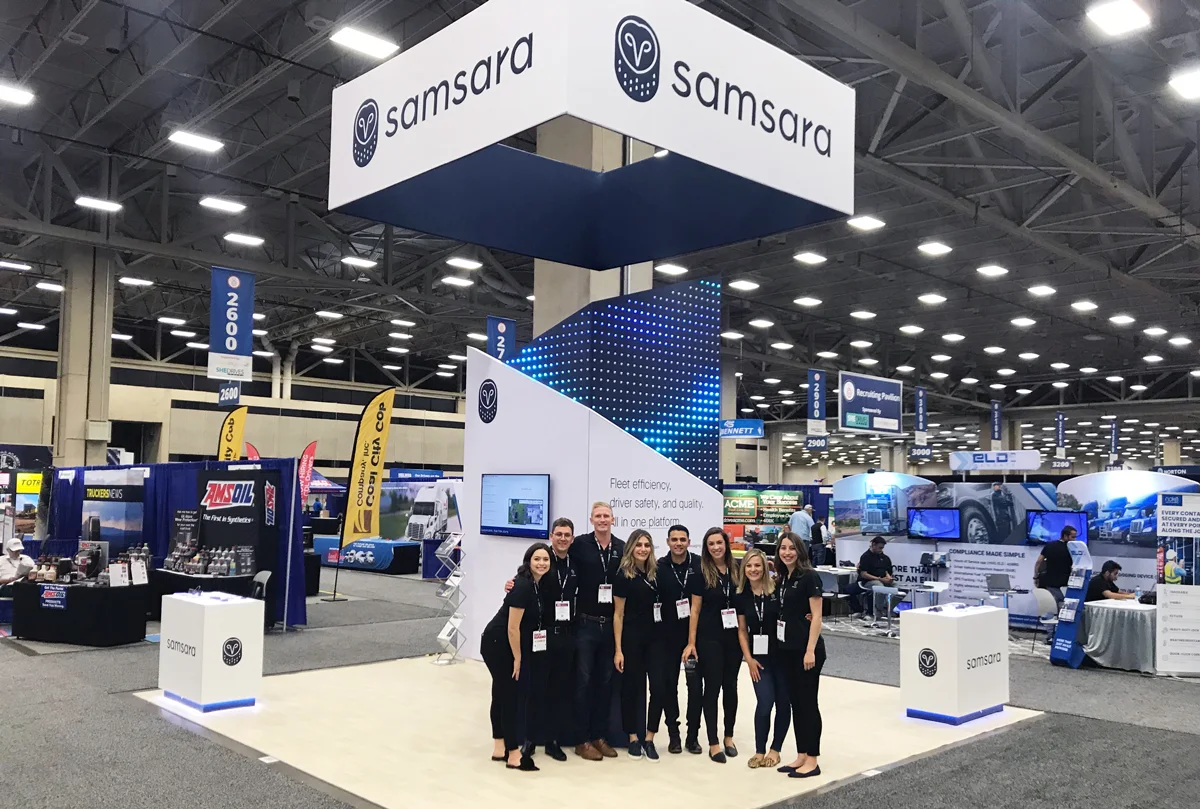Efficiency
3 Hot Topics from the FMCSA at the Great American Trucking Show
August 27, 2019
Manager, Content Marketing

Get the latest from Samsara
Subscribe nowLast week, thousands of truckers and exhibitors gathered in Dallas for the Great American Trucking Show (GATS), held annually in the Kay Bailey Hutchison Convention Center.
One of this year’s most highly anticipated sessions was hosted by the Federal Motor Carrier Safety Administration (FMCSA). Joe DeLorenzo, the FMCSA's Director of Enforcement and Compliance, discussed some of the trucking industry's hottest topics — from the new Drug & Alcohol Clearinghouse to the nitty-gritty on personal conveyance.
Whether you were in attendance or weren't able to make it to Dallas this year, keep reading to get the scoop on the FMCSA's latest tips and recommendations to help your fleet stay compliant.
1. What to know about the long-awaited Drug & Alcohol Clearinghouse
Starting on January 6, 2020, there will be a new way to run pre-employment checks on drivers. The FMCSA will finally launch the long-awaited Drug & Alcohol Clearinghouse, an online database that will compile all records of CDL drivers who have failed or refused a drug or alcohol test. Moving forward, driver violation records will be kept in the Clearinghouse for five years, or until the driver successfully completes the return-to-duty process.
The main purpose of the new database is to restrict drivers from gaming the current screening process.
“What the Clearinghouse is going to do is prevent a situation where a driver can show up to a company for a pre-employment test, get a positive test result, wait a couple of weeks, go to another employer, take another test, and begin working again,” said DeLorenzo. “It’s designed to close that loophole.”
With the official launch looming, DeLorenzo highlighted a few key features of the Clearinghouse that all carriers should keep in mind.
It should make employment checks easier, but not until 2023
Before hiring a new CDL driver, the FMCSA requires that you obtain a three-year drug or alcohol violation history. Currently, obtaining that three-year history can be quite cumbersome, since you have to contact previous employers and wait for their reply.
The Clearinghouse aims to solve this problem by providing a five-year history on all violations. But since data won’t start being collected until January 6, 2020, employers will have to conduct both electronic queries via the Clearinghouse and manual inquiries with previous employers until January 6, 2023, at which point the Clearinghouse will contain the minimum three years of historical data.
“For three years, you’re going to have to have a dual process, because you still have to check a three-year history,” said DeLorenzo. “Once that time is up and the Clearinghouse is populated, then the old process goes away.”
Each query will cost $1.25
Employers will have to pay the FMCSA a $1.25 fee for conducting a query in the Clearinghouse. C/TPAs cannot purchase queries on behalf of employers, so if you’re an owner-operator, you will have to purchase queries and give your C/TPA approval to run queries on your behalf.
DeLorenzo also noted that carriers will be able to buy and run queries in bulk. Although bulk queries aren’t discounted — for example, a bundle of 1,000 queries will cost $1,250 — they don’t ever expire, so bulk buys can reduce administrative hassle for large fleets.
Query plans will be available for purchase starting in November 2019, a few months before the launch date, and you can see the full query fee schedule on the FMCSA website.
Make sure to enter accurate CDL numbers
One of the most important things DeLorenzo highlighted was ensuring you have accurate CDL information and your driver lists are updated, especially if you’re going to be running bulk queries.
“The biggest problem I anticipate folks are going to have early on is making sure you get the CDL numbers in there correctly,” said DeLorenzo. “The Clearinghouse system is going to check the number you enter against the CDL system to make sure it’s valid information. Double check, otherwise it will kick it back and you’ll have to go through the process again.”
You can create an account starting in October
Registration for the Clearinghouse will open this October. All employers who hire CDL drivers will need to create an account in order to access the database, and starting in January, medical review officers will be required to submit positive tests.
DeLorenzo highlighted that drivers will need to create accounts, too — but only if they decide to switch jobs after January 6, 2020. That’s because “full queries” (conducted before employment) will require driver consent via the Clearinghouse, whereas “limited queries” (conducted annually for existing drivers) will still only require paper consent forms.
“After an employer requests a full query on a driver, the driver has to electronically consent for the query to happen,” said DeLorenzo. “That’s why those drivers will have to create accounts as well.”
DeLorenzo recommended carriers start thinking about how to incorporate the Clearinghouse into their hiring plan and create an account once registration opens in October.
“We’re trying to avoid a giant rush on January 5,” said DeLorenzo. “Registering is a pretty straightforward process, so be thinking about that and talking to your drivers about having their own account too.”
You can see more information on the Drug & Alcohol Clearinghouse on the FMCSA website.
2. ELD transition tips ahead of the upcoming deadline
With the ELD mandate deadline coming up fast on December 16, the AOBRD to ELD transition is top of mind for many carriers.
Now that we’re nearing the end of the ELD implementation timeline, the FMCSA has collected a trove of data on what’s causing challenges for fleets making the transition. With the hard deadline less than 4 months away, DeLorenzo went through common ELD issues and offered a few helpful tips for implementation.
Make the switch sooner rather than later
DeLorenzo said that investigation data indicates “increasing compliance” with the AOBRD to ELD transition, and less than 1% of inspections now include a violation for not having an ELD.
“If you haven’t done your AOBRD to ELD conversion yet, you really should be doing it now,” said DeLorenzo. “The last thing you want to do is be running around at the end of the year trying to do the conversion at the same time as everyone else.”
Start now by contacting a few different ELD providers and asking for a free trial. This will give you ample time to complete your trial before the upcoming deadline, so you can test the system and see how it performs before making a commitment.
Looking for an ELD vendor? Request a free trial of Samsara to get started today.
Train your drivers on the most commonly cited ELD violations
One of the most challenging parts of switching to ELDs is ensuring your drivers are comfortable enough with the system to confidently pass roadside DOT inspections.
According to DeLorenzo, the two most commonly cited ELD violations are:
Failing to maintain paperwork
Unable to perform data transfer
“When I look at violation data, it tells me that a lot of drivers didn't know whether they had an AOBRD or ELD when they tried to do a data transfer, and they couldn't get it to work because they weren't sure how to use their device,” said DeLorenzo. “That goes back to the driver training and driver reinforcement issue.”
Consider creating a training program for your drivers on how to transfer data records to the FMCSA during a roadside inspection, and make sure they always have their ELD instruction manual and data transfer instructions in their cab.
DeLorenzo noted it’s also important to give your drivers a refresher on how to prevent Hours of Service (HOS) violations. He emphasized that even after you switch to ELDs, your drivers still need have blank paper logs readily available, since the FMCSA requires that drivers switch to paper logs to continue accurately recording their HOS in the case of an ELD malfunction.
When in doubt, encourage drivers to add an annotation
You don’t have to switch to paper logs unless your ELD is not accurately recording HOS. For any other type of malfunction or issue — like adverse driving conditions — an annotation can be used to denote what happened.
“There are times when an annotation is required, but there are also times where it just might be a good idea,” said DeLorenzo. “Remember that the person who’s looking at your record wasn't there. Whenever anything is out of the ordinary, put it in an annotation.”
For more tips on ELD implementation, download our free eBook: How to Make a Smooth Transition from AOBRD to ELD
3. Understanding when to use (and not use) personal conveyance
Personal conveyance is one of those topics that’s difficult to nail down — everyone seems to have a different opinion on what qualifies as personal conveyance and what doesn’t. During his session, DeLorenzo addressed this controversy head-on, offering revised guidance on when and how to use personal conveyance as an appropriate duty status.
Focus on the purpose of the movement
DeLorenzo acknowledged that personal conveyance can be tricky to determine, especially since there are thousands of possible scenarios and each one is a little different. However, he recommended that drivers focus on the purpose of the movement in order to determine whether it qualifies as personal conveyance or not.
“Personal conveyance is simply a way to explain an off-duty status while the commercial motor vehicle is moving. If you start there, you should get the right answer every time,” said DeLorenzo. “The question is: ‘Am I doing something where I could be in an off-duty status, but I happen to be using a commercial vehicle?’”
DeLorenzo gave an example to help clarify. If your driver is dispatched from a terminal, drops off their load, and is then dispatched home empty, that last leg of the trip does not qualify as personal conveyance.
“It’s really important to remember that interstate commerce does not go in one direction. It’s a round trip movement,” said DeLorenzo. “You never would have been at the destination where you dropped the load if you weren’t there for a commercial purpose. The purpose of that movement is to finish the interstate trip, so that’s why it’s still considered on duty time.”
Establish and document a clear company policy
When it comes to determining personal conveyance on a case-by-case basis, DeLorenzo recommended that drivers and managers start with the basic principles. But with so much confusion around personal conveyance — and limited guidance from the FMCSA — DeLorenzo added that it’s a good idea to establish and document your own personal conveyance policy at your company.
“Keep in mind that as a company, it’s well within your purview to establish your own limits,” said DeLorenzo. “My only recommendation is that you make sure everybody in your company knows what your policy is and you have it documented in writing.”
You can find more information on personal conveyance on the FMCSA website.
See you next year at GATS!
Whether you stopped by our booth at GATS or couldn’t make it to Dallas this year, we’d love to hear from you! Get in touch any time at sales@samsara.com

Get the latest from Samsara
Subscribe now

















